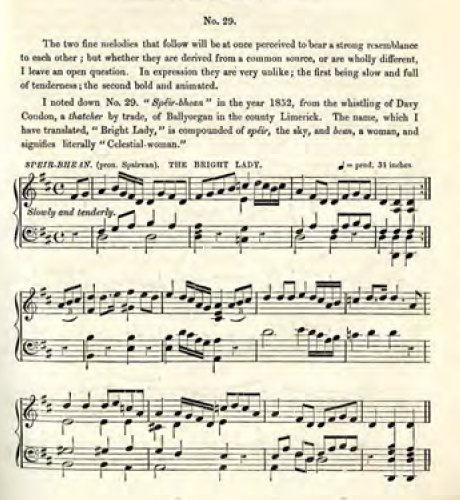Might help someone to know what the tune is. Is it this one?
https://www.tunearch.org/wiki/Bright_Lady
OR
ALAS, MY BRIGHT LADY. AKA and see "Fair at Dungarvan."
FAIR AT DUNGARVAN, THE (Aonac Dungarbain). AKA and see "Alas, My Bright Lady," “Dungarvan,” "Lament for Kilcash," "Nelly, My Love, and Me," "Rose Connolly," "There is a Beech‑Tree Grove," "Were You Ever in Sweet Tipperary?" Irish, Air (3/4 time). G Major. Standard tuning. One part. See note for “Lament for Kilcash.” O'Neill (O’Neill’s Irish Music), 1915/1987; No. 28, pg. 22. O'Neill (Music of Ireland: 1850 Melodies), 1903; No. 99, pg. 18.
X:1
T:Fair at Dungarvan, The
M:3/4
L:1/8
R:Air
N:”Moderate”
S:O’Neill – Music of Ireland (1903), No. 99
Z:AK/Fiddler’s Companion
K:G
GA |B4B2 | d4e2 | B4A2 | G4A2 | B4B2 | d4A2 | (B6 | B4) GA |
B4B2 | e4d2 | B4A2 | G4F2 | E2F2E2 | B4A2 | (G6 | G4) || GF |
E4E2 | E2F2G2 | F4E2 | D4F2 | E4E2 | E2F2E2 | B6 | A4F2 |
E4E2 | E2F2G2 | F4E2 | D4c2 | B4G2 | A4F2 | (G6 | G4) ||
LAMENT FOR KILCASH (Caoine Cill Cair/Cais). AKA and see "Dungarvan," "Alas, My Bright Lady," “The Fair at Dungarvan,” "Nelly, My Love, and Me," "Rose Connolly," "There is a Beech‑tree Grove," "Were You Ever in Sweet Tipperary." Irish, Air. A Jacobite song written about 1710. Kilcash was the old mansion of the Butler family (an old Norman family, long assimilated by the gaels) and the home of Lady Iveagh, the heroine of the song. It was set to its tune in 1745 by a Father Lane, who had been sponsered and educated for the priesthood by the Lady, who died in July 1744. O’Neill (1913) records that Kilcash is also the ancient seat of the Ormondes, a few miles northeast of Clonmel. Several songs were written to the melody, including “The Fair at Dungarvan.”
http://www.ibiblio.org/fiddlers/ROS_ROT ... E_CONNOLLY
FAIR AT DUNGARVAN, THE (Aonac Dungarbain). AKA and see "Alas My Bright Lady," "Dungarvan," "Lament for Kilcash," "Nelly My Love and Me," "Rose Connolly," "There is a Beech-Tree Grove," "Were you ever in sweet Tipperary?" Irish, Air (3/4 time). G Major. Standard tuning (fiddle). One part. O'Neill writes in Irish Folk Music, A Fascinating Hobby ():
A ballad called "The Fair at Dungarvan" was a great favorite in Munster, at least in the middle of the last (19th) century. The air, which I remembered since boyhood, was noted down and printed under that name, no other being known for it at the time. It developed, however, that it was an air of great antiquity, much varied by time and taste, but never beyond easy identification. As "Rose Connolly", Bunting printed it in 1840 in his third collection, The Ancient Music of Ireland, and notes that it was obtained in Coleraine in 1811, "author and date unknown." It is to be found under that name also in Surenne's Songs of Ireland, published in 1854. Probably its most ancient title was "The Lament for Cill Caisi", or "Kilcash", a setting of which is to be found in Dr. Petrie's Complete Collection of Irish Music. Among the songs which I find sung to this air are: "Alas, My Bright Lady," "Nelly, My Love, and Me," "There is a Beech-tree Grove," and "Were You Ever in Sweet Tipperary?"
See note for "Lament for Kilcash." "Rose Connolly" is a rather distanced version.
Source for notated version:
Printed sources: O'Neill (O'Neill's Irish Music), 1915; No. 28, p. 22. O'Neill (Music of Ireland: 1850 Melodies), 1903; No. 99, p. 18.
